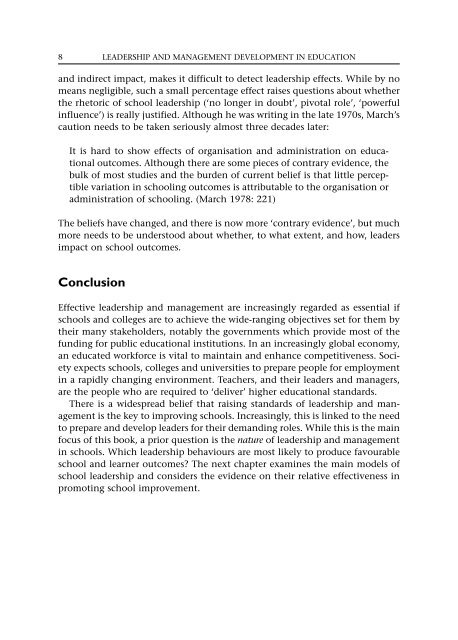Leadership and Management Development in Education (Education ...
Leadership and Management Development in Education (Education ...
Leadership and Management Development in Education (Education ...
You also want an ePaper? Increase the reach of your titles
YUMPU automatically turns print PDFs into web optimized ePapers that Google loves.
8LEADERSHIP AND MANAGEMENT DEVELOPMENT IN EDUCATION<strong>and</strong> <strong>in</strong>direct impact, makes it difficult to detect leadership effects. While by nomeans negligible, such a small percentage effect raises questions about whetherthe rhetoric of school leadership (‘no longer <strong>in</strong> doubt’, pivotal role’, ‘powerful<strong>in</strong>fluence’) is really justified. Although he was writ<strong>in</strong>g <strong>in</strong> the late 1970s, March’scaution needs to be taken seriously almost three decades later:It is hard to show effects of organisation <strong>and</strong> adm<strong>in</strong>istration on educationaloutcomes. Although there are some pieces of contrary evidence, thebulk of most studies <strong>and</strong> the burden of current belief is that little perceptiblevariation <strong>in</strong> school<strong>in</strong>g outcomes is attributable to the organisation oradm<strong>in</strong>istration of school<strong>in</strong>g. (March 1978: 221)The beliefs have changed, <strong>and</strong> there is now more ‘contrary evidence’, but muchmore needs to be understood about whether, to what extent, <strong>and</strong> how, leadersimpact on school outcomes.ConclusionEffective leadership <strong>and</strong> management are <strong>in</strong>creas<strong>in</strong>gly regarded as essential ifschools <strong>and</strong> colleges are to achieve the wide-rang<strong>in</strong>g objectives set for them bytheir many stakeholders, notably the governments which provide most of thefund<strong>in</strong>g for public educational <strong>in</strong>stitutions. In an <strong>in</strong>creas<strong>in</strong>gly global economy,an educated workforce is vital to ma<strong>in</strong>ta<strong>in</strong> <strong>and</strong> enhance competitiveness. Societyexpects schools, colleges <strong>and</strong> universities to prepare people for employment<strong>in</strong> a rapidly chang<strong>in</strong>g environment. Teachers, <strong>and</strong> their leaders <strong>and</strong> managers,are the people who are required to ‘deliver’ higher educational st<strong>and</strong>ards.There is a widespread belief that rais<strong>in</strong>g st<strong>and</strong>ards of leadership <strong>and</strong> managementis the key to improv<strong>in</strong>g schools. Increas<strong>in</strong>gly, this is l<strong>in</strong>ked to the needto prepare <strong>and</strong> develop leaders for their dem<strong>and</strong><strong>in</strong>g roles. While this is the ma<strong>in</strong>focus of this book, a prior question is the nature of leadership <strong>and</strong> management<strong>in</strong> schools. Which leadership behaviours are most likely to produce favourableschool <strong>and</strong> learner outcomes? The next chapter exam<strong>in</strong>es the ma<strong>in</strong> models ofschool leadership <strong>and</strong> considers the evidence on their relative effectiveness <strong>in</strong>promot<strong>in</strong>g school improvement.
















